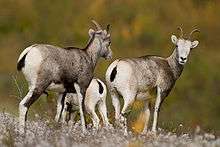Dall sheep
The Dall sheep, also known as the thinhorn sheep,[2] (Ovis dalli)[3] is a species of wild sheep native to northwestern North America, ranging from white to slate brown in colour and having curved, yellowish-brown horns. The two subspecies are the nominate Dall sheep or Dall's sheep and the more southern subspecies, Stone sheep (also spelled Stone's sheep) (O. d. stonei), which is a slate brown with some white patches on the rump and inside the hind legs.
| Dall's sheep | |
|---|---|
 | |
| ram | |
.jpg) | |
| ewe both in Denali National Park in Alaska | |
| Scientific classification | |
| Kingdom: | Animalia |
| Phylum: | Chordata |
| Class: | Mammalia |
| Order: | Artiodactyla |
| Family: | Bovidae |
| Subfamily: | Caprinae |
| Genus: | Ovis |
| Species: | O. dalli |
| Binomial name | |
| Ovis dalli Nelson, 1884 | |
| Subspecies | |
| |
 | |
Taxonomy and genetics
Research has shown the use of these subspecies designations is questionable. Complete colour intergradation occurs between white and dark morphs of the species with intermediately coloured populations, called Fannin sheep (O. d. fannini), found in the Pelly Mountains and Ogilvie Mountains of the Yukon Territory.[4] mitochondrial DNA evidence has shown no molecular division along current subspecies boundaries,[5] although evidence from nuclear DNA may provide some support.[6] Also at the species level, current taxonomy is questionable because hybridization between O. dalli and O. canadensis has been recorded in recent evolutionary history.[5]
The species name, dalli, is derived from William Healey Dall (1845–1927), an American naturalist. The common name Dall sheep or Dall's sheep is often used to refer to the species O. dalli. An alternative use of common name terminology is that thinhorn sheep refers to the species O. dalli, while Dall's sheep and Stone's sheep refer to subspecies O. d. dalli and O. d. stonei, respectively.
Natural history
Ecology
The sheep inhabit the subarctic mountain ranges of Alaska, the Yukon Territory, the Mackenzie Mountains in the western Northwest Territories, and central and northern British Columbia. Dall sheep are found in relatively dry country and try to stay in a special combination of open alpine ridges, meadows, and steep slopes with extremely rugged ground in the immediate vicinity, to allow escape from predators that cannot travel quickly through such terrain.
Male Dall sheep have thick, curling horns. The females have shorter, more slender, slightly curved horns. Males live in bands which seldom associate with female groups except during the mating season in late November and early December. Lambs are born in May.
During the summer when food is abundant, the sheep eat a wide variety of plants. The winter diet is much more limited, and consists primarily of dry, frozen grass and sedge stems available when snow is blown off, lichen, and moss. Many Dall sheep populations visit mineral licks during the spring, and often travel many miles to eat the soil around the licks.[7]
Primary predators of this sheep are wolf packs, coyotes, black bears, and grizzly bears; golden eagles are predators of the young. The Dall sheep has been known to butt gray wolves off the face of cliffs.
Dall sheep can often be observed along the Alaska Highway at Muncho Lake in British Columbia, along the Seward Highway South of Anchorage, AK, within Denali National Park and Preserve (which was created in 1917 to preserve Dall sheep from overhunting), at Sheep Mountain in Kluane National Park and Reserve and near Faro, Yukon (Fannin's sheep).
Gallery
.jpg) Dall ewe and lamb group in Denali National Park
Dall ewe and lamb group in Denali National Park Two Dall sheep lambs
Two Dall sheep lambs Stone sheep near roadway in British Columbia
Stone sheep near roadway in British Columbia.jpg) Taxidermied specimens at the American Museum of Natural History
Taxidermied specimens at the American Museum of Natural History
References
- Festa-Bianchet, M. (2008). "Ovis dalli". IUCN Red List of Threatened Species. 2008: e.T39250A10179389. doi:10.2305/IUCN.UK.2008.RLTS.T39250A10179389.en. Database entry includes a brief justification of why this species is of least concern.
- Thinhorn sheep (Ovis dalli) Archived 8 March 2016 at the Wayback Machine, Arkive.org
- Thinhorn Sheep (Ovis dalli), Yukon Wildlife Preserve
- Sheldon, C. (1911). The Wilderness of the Upper Yukon. First edition. Charles Scribner's Sons, New York.
- Loehr, J.; K. Worley; A. Grapputo; J. Carey; A. Veitch; D. W. Coltman (2006). "Evidence for cryptic glacial refugia from North American mountain sheep mitochondrial DNA". Journal of Evolutionary Biology. 19 (2): 419–430. CiteSeerX 10.1.1.574.4471. doi:10.1111/j.1420-9101.2005.01027.x. PMID 16599918.
- Worley, K.; Strobeck, C.; Arthur, S.; Carey, J.; Schwantje, H.; Veitch, A. & Coltman, D.W. (2004). "Population genetic structure of North American thinhorn sheep Ovis dalli" (PDF). Molecular Ecology. 13 (9): 2545–2556. doi:10.1111/j.1365-294X.2004.02248.x. PMID 15315669. Archived from the original (PDF) on 29 March 2012.
- Home Page, Alaska Department of Fish and Game. Adfg.state.ak.us. Retrieved on 16 September 2011.
Further reading
| Wikimedia Commons has media related to Ovis dalli. |
- Banfield, A.W.F. (1974). The Mammals of Canada. University of Toronto Press. ISBN 0-8020-2137-9
- Ovis dalli. Brower and Leslie
- Smithsonian Institution - North American Mammals: Ovis dalli
